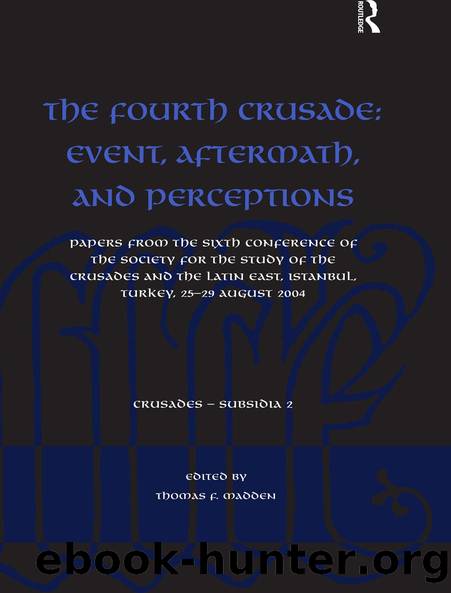The Fourth Crusade: Event, Aftermath, and Perceptions by Thomas F. Madden

Author:Thomas F. Madden [Madden, Thomas F.]
Language: eng
Format: epub
Tags: History, Europe, Medieval, Middle East, Turkey & Ottoman Empire
ISBN: 9780812217131
Google: 0NpWFGvA5VQC
Publisher: University of Pennsylvania Press
Published: 1999-09-02T16:19:21+00:00
PERCEPTIONS
The Translatio Symonensis and the Seven Thieves: A Venetian Fourth Crusade Furta Sacra Narrative and the Looting of Constantinople
David M. Perry
On Palm Sunday of 1204, twelve Venetian crusaders ventured out from their ship into the chaotic city of Constantinople.1 They planned to steal relics. All twelve came from the parish of St. Simon the Prophet in Venice, and their intention was to take home the relics of their parishâs patron saint from the Church of St. Mary Chalkoprateia, located close to Hagia Sophia on the Golden Horn. The men had reconnoitered the premises a few days earlier, because one of the Venetians, Pietro Steno, had seen the relics while in the city on business in 1201, but needed to retrace his steps to find them again. With this accomplished, the conspirators made their plans, and on Palm Sunday had put them into motion. But the best laid plans of Venetian crusaders often went awry.
So begins the Translatio Symonensis, a relatively recently discovered source for the Fourth Crusade.2 This narrative describes the âtranslationâ (the term used when one moves relics from one place to another) of the relics of St. Simon the Prophet from Constantinople to Venice. It covers the follies and successes of these crusaders as they find the relics and smuggle them out of the church, eventually sending the sacred items back to Venice. Drawing from chronicle sources and an inscription on the tomb in Venice (where the relics eventually were deposited), scholars knew that Venetians took St. Simon from Constantinople after the Fourth Crusade, but lacked the details of the theft. This translatio provides them. Thanks to the research of Paolo Chiesa, the full story of the theft of St. Simon is now available for scholars of the Fourth Crusade.3
This article will consider two groups of questions about the text and the story it relates. First, the text: What does it say? Where does it come from? Who wrote it? Is the narrative historically accurate? Second: Who were these Venetian relic thieves and what is the significance of their decision to steal the relics of their patron saint from Constantinople and bring them home to Venice?
Download
This site does not store any files on its server. We only index and link to content provided by other sites. Please contact the content providers to delete copyright contents if any and email us, we'll remove relevant links or contents immediately.
Room 212 by Kate Stewart(5035)
The Crown by Robert Lacey(4722)
Endurance: Shackleton's Incredible Voyage by Alfred Lansing(4676)
The Iron Duke by The Iron Duke(4291)
The Rape of Nanking by Iris Chang(4136)
Joan of Arc by Mary Gordon(4013)
Killing England by Bill O'Reilly(3951)
Say Nothing by Patrick Radden Keefe(3903)
I'll Give You the Sun by Jandy Nelson(3357)
Shadow of Night by Deborah Harkness(3299)
Hitler's Monsters by Eric Kurlander(3268)
Mary, Queen of Scots, and the Murder of Lord Darnley by Alison Weir(3148)
Blood and Sand by Alex Von Tunzelmann(3138)
Darkest Hour by Anthony McCarten(3070)
Eleanor & Park by Rainbow Rowell(3062)
Margaret Thatcher: The Autobiography by Thatcher Margaret(3028)
Red Famine: Stalin's War on Ukraine by Anne Applebaum(2873)
Book of Life by Deborah Harkness(2867)
The One Memory of Flora Banks by Emily Barr(2802)
